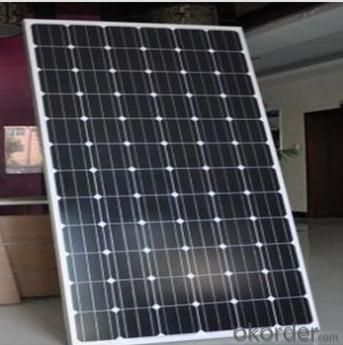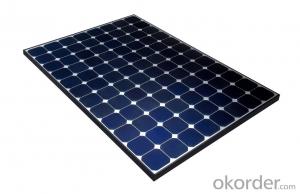CNBM Mono Solar Panel 265W A Grade with Factory Price
- Loading Port:
- Shanghai
- Payment Terms:
- TT OR LC
- Min Order Qty:
- 100 watt
- Supply Capability:
- 100000 watt/month
OKorder Service Pledge
OKorder Financial Service
You Might Also Like
Item specifice
CNBM Moly Solar Panel 265W A Grade with Factory Price
Production description
A solar panel is a collection of solar cells. Lots of small solar cells spread over a large area can work together to provide enough power to be useful. The more light that hits a cell, the more electricity it produces, so spacecraft are usually designed with solar panels that can always be pointed at the Sun even as the rest of the body of the spacecraft moves around, much as a tank turret can be aimed independently of where the tank is going.
Each module is rated by its DC output power under standard test conditions, and typically ranges from 100 to 365 watts. The efficiency of a module determines the area of a module given the same rated output – an 8% efficient 230 watt module will have twice the area of a 16% efficient 230 watt module.
A solar cell, or photovoltaic cell, is an electrical device that converts the energy of light directly intoelectricity by the photovoltaic effect, which is a physical and chemical phenomenon.[1] It is a form of photoelectric cell, defined as a device whose electrical characteristics, such as current, voltage, or resistance, vary when exposed to light. Solar cells are the building blocks of photovoltaic modules, otherwise known as solar panels.
Application
Aerospace
Residential
Commercial
Large solar power plant
Distributed plant
Product Feature
1.A grade high efficiency solar cells.
2.TUV/UL/CE/CEC etc
3.Fast shippment
4.25 years warranty
5.OEM
Package
24pcs into one carton, 312pcs into a 20 foot container, 728pcs into a 40 foot container.
- Q:I'm curious, for those who have had solar panels installed on the rooves of their houses:How much did you pay? How much energy do the panels produce? Did it dramatically cut down on your electricity bill? Was it worth it? Thanks!
- I'm okorder /
- Q:hi,i have 4 solar panels. I can get 9V 400mA when i wired them parallel. The question is: how can i make a regulator circuit to store power into batteries.
- wire them in series parallel to get 8 volts at 200 mA, and that should charge a 2 volt battery. You may want to put in a series diode to prevent the battery from discharging into the panel when the sun is out. At 200 mA, depending on the battery size, you may not need much control, as that low a current will not overcharge a large battery, like a small auto battery. In fact it will take a very long time to charge it. edit: But do i need to add a regulator? If by that you mean a voltage regulator, no, as a solar panel has a high output resistance, and that will limit the current into the battery. If you mean a charge controller, if the battery is small, you may need a charge contoller to avoid overcharging the battery. But that is not a voltage regulator. .
- Q:I am seriously thinking about installing PhotoVoltais Solar panels (that generate electricity) on my roof. Besides the usual (cost, ROI, etc.), I was researching for the maintenance of these panels. We have tall trees around the house and needles and leaves fall on our roof all the time... not to mention the dirt and grime that collects over time.Do these decrease the capacity of the panels? Do the panels require a regular maintenance?Thanks!
- panels need full sun. any shade reduces out put. leaves left on them will cause the individual cells burn out. they nneed adjusting every season, an washed with a soft cloth once a year.
- Q:I am going to be building green in the next couple of years and i need an idea of how many solar panels i need in addition to a wind turbine to sufficiently handle a workshop, house, green house, etc. and what the approximate cost will be.
- I think Brian's answer was perfect for the US, but in the UK, with very high gas and oil prices, we would also look at hydrogen production from the wind turbine instead of a battery store, where excess capacity could be used to heat the house or potentially act as a car fuel. Alternatively we would look to selling back excess electricity to the grid.
- Q:How much would solar panels cost for: A Cell phoneA average houseA car
- in case you recognize the place to look you get get image voltaic panels for 0 expenses. as an occasion, numerous sign companies use image voltaic panels. touch your interior sight sign company and tell them you will haul off all their broken image voltaic panel for loose. they're oftentimes extra beneficial than keen to assist you are trying this.
- Q:Can solar panels be used to heat water?
- Yes, solar panels can be used to heat water. Solar thermal systems, also known as solar water heaters, use sunlight to heat water and are more efficient at heating water compared to using solar panels for electricity generation. These systems capture the sun's energy and transfer it to a fluid, which then heats the water for various applications such as domestic use, swimming pools, and commercial purposes.
- Q:we are trying to reduce a solar panel from 9 volts to 3 volts. What do we need to make this work...
- Solar panels generate DC power. Changing DC voltage is hard, which is why the power grid is AC voltage. AC voltage can easily be changed with a transformer. To keep the DC power (watts) the same at a lower voltage you need a DC to DC converter. That basically changes the power to AC with an inverter, changes the AC voltage to the new value, then rectifies it back to DC. It is probably hard to find a commercial unit that handles those voltages and then it will be expensive. But I have a simple solution in the special case of a solar panel. Solar panels are made up of smaller solar cells. The basic solar cell has a very low voltage, like half a volt. The panel has many of them connected in series to make a higher voltage. Just cover (shade) some of them and the voltage generated by the panel will be less. Of course that reduces the power. And you may need to experiment with shading different parts of the panel and measuring the result with volt meter.
- Q:Can solar panels be installed on a building with historical significance?
- Yes, solar panels can be installed on a building with historical significance. However, it is important to consider the potential impact on the building's aesthetics and historical value. Careful planning and consultation with preservation experts can help ensure that the installation is done in a way that minimizes any negative visual or structural impact on the building while still harnessing the benefits of solar energy.
- Q:How do solar panels reduce carbon emissions?
- Solar panels reduce carbon emissions by harnessing the power of the sun to generate electricity. Unlike traditional energy sources such as coal or natural gas, solar energy does not produce any greenhouse gases when converted into electricity. By utilizing solar panels to generate power, we can reduce our reliance on fossil fuels and significantly decrease carbon emissions, contributing to the fight against climate change.
- Q:Can solar panels be installed on a boat or yacht?
- Yes, solar panels can be installed on boats or yachts. In fact, they are becoming increasingly popular as a source of renewable energy for marine vessels. Solar panels can provide power for various onboard systems, such as lighting, electronics, and refrigeration, reducing the reliance on generators or shore power. Additionally, solar panels are lightweight, durable, and can be easily installed on the deck or roof of a boat or yacht, making them a practical and efficient choice for harnessing clean energy at sea.
1. Manufacturer Overview |
|
|---|---|
| Location | |
| Year Established | |
| Annual Output Value | |
| Main Markets | |
| Company Certifications | |
2. Manufacturer Certificates |
|
|---|---|
| a) Certification Name | |
| Range | |
| Reference | |
| Validity Period | |
3. Manufacturer Capability |
|
|---|---|
| a)Trade Capacity | |
| Nearest Port | |
| Export Percentage | |
| No.of Employees in Trade Department | |
| Language Spoken: | |
| b)Factory Information | |
| Factory Size: | |
| No. of Production Lines | |
| Contract Manufacturing | |
| Product Price Range | |
Send your message to us
CNBM Mono Solar Panel 265W A Grade with Factory Price
- Loading Port:
- Shanghai
- Payment Terms:
- TT OR LC
- Min Order Qty:
- 100 watt
- Supply Capability:
- 100000 watt/month
OKorder Service Pledge
OKorder Financial Service
Similar products
New products
Hot products
Hot Searches
Related keywords




























